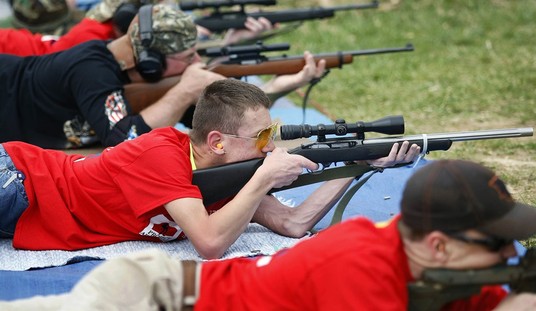While the homeowner was taking an afternoon nap, he awoke to a knocking at the front door. The knocking got louder and more insistent. As the drowsy homeowner started to get up from his slumber, the doorbell began to ring frantically. He looked out an upstairs window just in time to see two men walk away from the front of his house and go to the side of his house.
He realized that something was suspicious, and dialed 911. He left the phone off of the hook and grabbed his handgun as he headed downstairs. When he got to the bottom of the stairs, he heard the sound of breaking glass coming from his kitchen, at the rear of his house. He cautiously entered the kitchen area and startled the two would-be burglars as one of them was reaching through a broken windowpane in the door. They took off running and the homeowner gave chase in his bare feet, remarkably without cutting his feet on the broken glass.
As the homeowner rounded the corner of his house, he lost sight of the two burglars, but caught a third burglar during his attempt to run from the front of the house to his vehicle. The homeowner held the third suspect at gunpoint until the police arrived. He quickly gave up the names of his two accomplices and all three were charged with attempted burglary. This is just one of many true life stories involving multiple assailants. Luckily for this homeowner, these suspects were not armed, but that is not always the case.
An elderly couple was enjoying a night of television after finishing their evening meal when there was a knock at the door. As the husband answered the door, it was pushed open by two armed thugs. They proceeded to duct tape the couple and began pistol-whipping the elderly male. When they focused their attention on the man’s wife, he was able to break free of his bonds and retrieve his handgun. A gunfight ensued and the bandits ran from the house. One made it as far as the front porch before collapsing and dying. The second one was arrested at a local hospital after seeking treatment for his gunshot wound. The elderly couple was treated and released from the hospital that same night with minor cuts and bruises.
For some unknown reason, a lot of us are under the misconception that gunfights are one-on-one battles, man against man. Maybe we got this idea from watching too many old western movies where the good guy goes up against the bad guy gunslinger in the town square. Whatever the reason is for this perception, the reality of a gunfight is that you will more than likely be facing more than one adversary. How often does this occur? The FBI has done, and continues to do extensive research in the area of shootings that involve law enforcement officers. The FBI actually conducts extensive interviews with these criminals who have committed the ultimate crime against society, which is the murdering of a police officer. In one study they conducted, of the killers interviewed, 46% of them were "in the company of others" when they killed the officer.
How does this figure relate to you, the average citizen? Law enforcement officers and the average citizens on the street go up against the same criminals, so that 46% applies to you as well. The homeowner calls the police because there’s an armed man breaking into his house. If the drug-crazed gunman breaks into the house before the police arrive, the homeowner confronts the criminal with his firearm. The criminal runs off, and the police give chase. The same mugger that sticks a gun into your ribs on the street is going to be the same guy that the police stop for questioning because he’s acting suspicious and "kind of" matches the description of a stick-up man working the area.
So how do you even the score when going up against multiple assailants? Your first priority is to move. Move to cover if possible. In shootings that involve police officers, 95% of the officers who are able to move to cover, and use that cover effectively survive the shooting incidents. That’s a huge percentage that cannot be ignored. If you carry a firearm for self-defense, you should always be thinking tactically, and that means always thinking about what is cover, and how you can best move to it.
The chances are, even if you are thinking tactically, that there may not be any cover available for you to move to. The vast majority of gunfights are up close and personal events, whether law enforcement or civilian. So the chances of there being some type of cover in between you and the bad guy are pretty slim. But even if there is no cover available, you should still move.
Moving accomplishes several things. First of all, it makes you a harder target to hit. In one of the FBI’s studies, they discovered that of the cop killers interviewed, 54% of them practiced with the weapons at least once a month. Yet 74% of them stated that their firearms practice was informal and at various locations, basically plinking at some cans in the woods or at some abandoned warehouse. What this means is that very few criminals have had any type of formal firearms training, and even fewer yet have had any type of formal firearms training that involved shooting at a moving target, let alone shooting at a moving target that’s shooting back at them.
By moving, you also make yourself a more distant target to shoot at. The majority of fatalities in gunfights are at close distances. So make yourself a more distant and difficult target to shoot at by moving out of the kill zone. Since the majority of bad guys have had no formal firearms training, they are going to have some difficulty shooting at a moving, distant target.
One other very important thing that you accomplish by moving is that you create action. We all know that action is faster than reaction. The bad guy creates action by going for his gun. You react by going for your gun. In essence, you are playing catch up to the suspect’s action. We turn this around by moving at the same time that we are going for our gun. Now the bad guy has to react to our action, our movement. We want to make him play catch up to us.
But how should you move? Your first priority is to move to cover if possible. But as was stated earlier, there probably isn’t going to be much cover available to you. Even if there is, it’s going to be difficult for you to move to it. It’s said that the average gunfight is over in seven seconds or less. The actual exchange of rounds takes approximately 2.5 to 3.5 seconds. If your cover isn’t within one or two steps of you, it’s going to be difficult for you to move to that cover within such a short amount of time.
If your cover is not within a couple of steps, your best bet is to move laterally. It is highly unlikely that two or three bad guys are going to be standing abreast of one another in a straight line like a row of targets on the firing line at the shooting range. Instead, they are likely to be standing apart from each other in some type of staggered configuration. If this is the case, then you can use the bad guy’s positions against one another by moving laterally. Let’s say that you’re going up against three armed thugs. The guy in front (the closest one to you) is armed with a knife and the other two behind him are armed with handguns. If you try to run backwards, the guy with the knife is going to run right over the top of you, because he can move faster going forward than you can move running backwards. Plus, the two in back are going to flank out to the first guy’s sides and get a good shot at you.
This time, instead of moving backwards, move laterally to one side, preferably to your gun (strong) side. If the bad guy who is armed with the knife is charging at you, he’s going to have to change directions to keep up with you. This will slow him down because he has to react to your action. This is also going to put everyone into a crossfire situation, forcing the bad guys in back to either hold their fire or shoot their accomplice in the back, either of which works to your benefit.
Why move to your strong side? Most shooters find it easier to move to their strong side. If it’s easier, then it’s going to be faster. A lot of police officers and bad guys are shot in their gun hand, gun arm and gun side of their body because under stress we have a natural tendency to focus in on the source of the danger. In an armed confrontation, the source of the danger is going to be the weapon. Since we are already looking in that direction, it only makes sense that our rounds are going to go in that direction once the you-know-what hits the fan.
If this is the case, then we want to protect our gun side as much as possible so we can stay in the fight for as long as possible. If you’re serious about your self-defense, you probably have done some off-hand shooting. But look at this realistically. You’re probably a much better shot with your strong hand. You’re outnumbered, and this whole confrontation is going to be over in a matter seconds. Your ability to survive this encounter is going to depend on your shooting skills, so you’ll want to protect your shooting hand and arm as much as possible.
We’ve discussed cover and movement, so now let’s talk about who to shoot, and how to do it. You’ll want to shoot the closest person to you first, no matter what weapon they possess. That person poses the greatest threat to you, because he or she is the closest. Someone who is five feet away from you obviously poses a greater threat to you than someone who is fifteen feet away from you. Shoot the closest threat to you while moving laterally out of the kill zone.
Once you’ve done this, shoot the next closest threat on your strong side so you can protect your ability to stay in this gunfight. The longer your gun side is exposed, the higher the probability that you will suffer a disabling injury to your shooting side.
Fire one round into each adversary, and then move onto the next. Firing multiple rounds into your adversary is the best way to incapacitate them, but you are outnumbered and out gunned, so you’re going to want to "put a hurting" on these guys as quickly as you can. Fire one round into each adversary and then go back for a follow-up shot if needed.
If you’re serious about your self-defense, then you need to train for the real world, and that means training for the possibility of going up against multiple assailants. Train hard, follow the guidelines on dealing with such situations, and you’ll even the score.
This article is provided by our friends at the United States Concealed Carry Association.








Join the conversation as a VIP Member